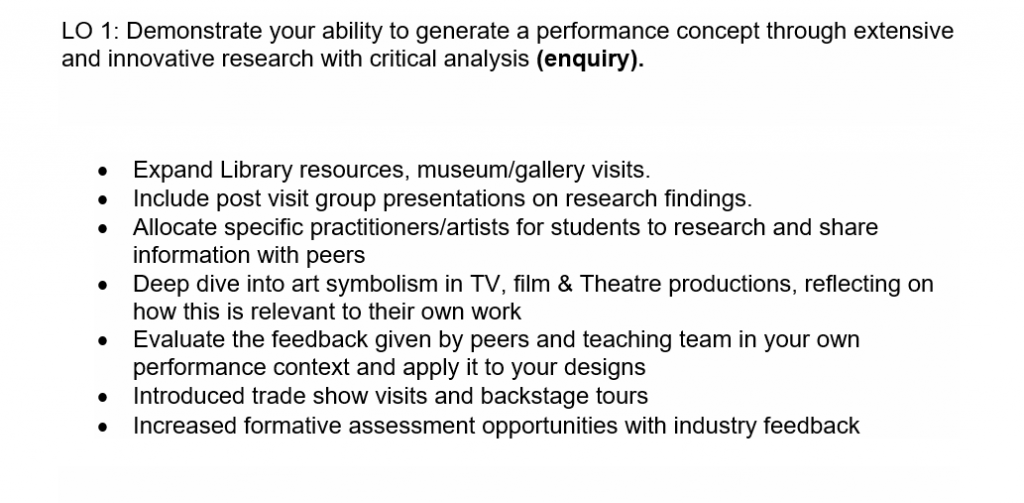Moving into a new building
In September 2023 LCF moved to its new home in Stratford East London into a purpose built 13 floor building designed to foster collaboration with everyone under one roof, and such esteemed neighbours as Sadler’s Wells and The V&A.
https://www.arts.ac.uk/colleges/london-college-of-fashion/about-lcf/lcfs-move
Weeks before the start of term we were told the Hair make up and prosthetics rooms were not completed. We had to find alternative spaces for hair, make-up and prosthetics lessons.
My issues were:
- Prioritising year groups
- Finding spaces to adapt
- Hiring specialist equipment
- Negotiating with students
- Rearranging the timetable
- Adapting delivery
- Find extra funding
- Fulfilling Learning Outcomes
Year 3 were prioritised. I analysed the LO’s to identify the focus areas within our limited resources. (see images below)



Their first unit is experimentation and research for the final project. I emphasised the importance of in depth research, an area often neglected. I increased outside visits and masterclasses from visiting industry professionals (which I opened to all year groups) this increased networking opportunities, employability and industry knowledge.
We found two rooms not in use and hired location filming equipment to create a film and TV crowd room set up for hair and makeup lessons. This increased employability focus by recreating industry conditions.
We introduced alternative prosthetics products and processes allowing exploration of more sustainable products.
For year 1 we focused on hair/wig and make up sessions as we could accommodate these more easily. I created a new bald cap making session which didn’t require specialist rooms but utilised transferrable skills and pushed creativity. This was very successful and something we have kept in the curriculum.
For year 2 we also pushed hair/wig and make up skills and brought forward some of the portfolio and preparation for industry sessions which would normally be in year 3. This increased understanding of industry expectations.
In year 2 students elect to either go on placement or do a KE project. This helped free limited resources as all students were off campus the majority of the time. The KE project was a live theatre production focused on hair, makeup and wigs skills.
Year 2 KE Project images taken by me February 2024



Just before the spring break we had solved the main room delay issues and could use most of our specialist rooms. Year 3 students were given access to the rooms over the Spring break to catch up.
My approach was to push employability, offering increased industry masterclasses, alumni talks, trips and events. I was able to offer certain hair and make sessions so these were increased allowing me to offer more diversity within sessions.
I created focused workshops customized around the resources available. This resulted in themed workshops we have kept in the curriculum.
Analysing student feedback the following aspects were the most successful:
- Recreating industry conditions
- Meeting industry professionals
- Alumni experiences
- Themed workshops
As a result of these changes our current 2nd & 3rd year students have a strong understanding of industry expectations, good communication skills and increased resilience and confidence.
This all aligns with work based learning theories such as Situated learning theory, ‘Learning is an integral part of the social practice in which it is based’… (Lave 1991) and that; ‘Education is not preparation for life it is life itself’’ ( Dewey 1916)
Bibliography:
Dewey, J., 1916. Democracy and education: An introduction to the philosophy of education. New York: Macmillan.
https://www.globalgreyebooks.com/democracy-and-education-ebook.html
Lave, J., 1991. Situated learning: Legitimate peripheral participation. Cambridge: Cambridge University Press.
